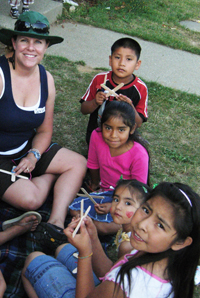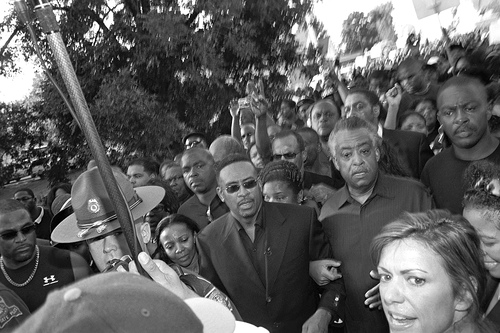Innovative Teaching Showcase
Portfolio

Introduction
I tell my students I am going to engage them in discussions, exercises, and fieldwork practices of things I wish I had experienced in the classroom—rather than as a working journalist in the field, on deadline, without guidance, and without anyone with whom I could discuss ideas and concerns. As a journalist, I often covered underrepresented communities in which I had to learn to communicate in different ways, check my assumptions at the door, discern values, and earn the trust of people whose lived experience was different than mine. To ask the right questions, to step with both feet into different environments, to convey others' perspectives accurately, and to broaden coverage beyond "official" sources are at the heart of good journalism. They need to be part of a comprehensive journalism education. My goal is not to tell students what to do or think or say in regard to diversity, but how to enter into new experiences and to, as best they can, see issues through other peoples' eyes.
In my view, teaching about diversity is not issue-specific or designed to study a different non-dominant "other-of-the-week." People and issues don't fit in tidy categories; and good teaching and good journalism recognize that. In my class, teaching diversity is based on self-examination, mindset, and approach.
Diversity as an Ethical Issue
 My approach teaches diversity as an ethical tenet of
good journalism. For example, an ethical reporter:
My approach teaches diversity as an ethical tenet of
good journalism. For example, an ethical reporter:
- Constantly questions her or his motives and assumptions,
- Recognizes and avoids stereotypes both in interviewing and writing,
- Seeks out people who are living an issue to speak their own truths,
- Seeks out sources who will shed new light on different dimensions of issues, and
- Is grateful for the gift of knowledge gained through interacting with someone who has a perspective the reporter had not considered.
When we teach our students to be skeptics, that should include being skeptical of their own assumptions. I tell my students never to be ashamed at not knowing, but never to make excuses for not finding out, even when it's uncomfortable to do so. We are all the products of our lived experience and we are all limited by those experiences. Journalists should portray the full picture of issues and impacts. That means getting beyond the loudest or handiest sources, and seeking all, not both, sides to provide nuanced portrayals of people and issues. Good journalists seek out the sources who won't necessarily find them.
Experiential Learning
Examining Faultlines
I explore the concepts of Faultlines based on race/ethnicity, gender, class, generation, and geography (see How to Cross Your 'Faultlines', Society of Professional Journalists' Diversity Toolbox). Students write down (for their own eyes only) a list of their Faultlines, which they are urged to consult throughout the term. Students focus on talking to sources who have different Faultlines than they do. We go through several examples of how Faultlines can cause reporters to report a story differently--or not at all (see also: The Authentic Voice: The Best Reporting on Race and Ethnicity). Because we are all limited by our Faultlines, reporters need to conduct Listening Posts to draw on others' lived experience.Conducting Listening Posts in the Community
(See The Listening Post by Keith Woods)A listening post requires students to talk to people they are not likely to encounter in the course of their normal daily routines (which are quite often limited to the few blocks around campus), or at a City Council meeting. These people are:
- Stakeholders in issues we cover.
- Stakeholders in issues we have yet to learn about.
- Sources who give us new perspectives, from the fisherman mending his net on the dock to the man sweeping the floor at the Sikh temple, to the still-out-of-work single parent on the playground.
Bringing Lived Experience into the Classroom
I bring in speakers and working journalists who are particularly comfortable with talking about issues such as race, sexual orientation, or mental illness from the perspective of their own lived experience. In the beginning, students are often reluctant to ask questions, so I use this as an opportunity to model interviewing about sensitive issues. The best way is direct, but respectful. This process helps build student confidence as does hearing the speakers openly address topics that are often taboo. It also helps students learn a lesson many journalists have not: one person does not speak for an entire demographic.
Giving Opportunities Outside of the Classroom
 Carolyn
Nielsen at Circulo de Manos, a summer enrichment
program at local migrant farm worker camps
Carolyn
Nielsen at Circulo de Manos, a summer enrichment
program at local migrant farm worker camps
Critical-thinking Skills
Incorporating Diversity in the Learning Environment
Some have a chapter about it toward the end. Diversity should not be an add-on, stand-alone lesson, but part of every discussion. I do address specific issues, such as racial identifiers in news stories (see Handling Race and Ethnicity, Poynter Institute), but we talk about diversity at every possible teaching moment. Recognizing those opportunities is essential, and setting up a learning environment in which they can happen isn't difficult, but it does take commitment to mindful choices.- Choose a textbook that features images of,
anecdotes about, and/or writing by women and/or men
of color. (In two of my courses, I don't have
textbooks because I can't find books that meet this
criteria. Instead, I construct a packet of materials
or links to readings both scholarly and
journalistic.)

- If students are assigned to cover a speech, for example, choose one that incorporates a diversity theme and let them learn about covering tough topics in an environment where their work will not be published. Talk about the challenges both before and after the assignment. Diversity angles are often overlooked not because they are unimportant, but because students are nervous to take them on. Make such coverage the norm and the expectation in your classroom.
- In your own examples, model diversity. I often use examples from ethnic-media sources, such as New American Media, to explain a common point about journalism. This sends the message that journalism should be defined inclusively.
- Begin class with a warm-up exercise examining a diversity-based ethical issue such as sourcing in a front-page story, a graphic image, a description or label, or a framing issue (e.g. portraying people with mental illness as a danger to society.) The idea here is not to see what was "wrong," as often times the class will praise the coverage, but to learn which questions to ask to explore the issue. A good source for examples is the Poynter Institute's Diversity at Work website.
- Familiarize students with resources. Language choice is a key concept in journalism, but the AP Stylebook is not especially progressive. Other journalism organizations provide different perspectives on language use. For example, the Native American Journalists Association (see Watch Your Language, Society of Professional Journalists), National Association of Hispanic Journalists, National Association of Black Journalists, Asian American Journalists Association, South Asian Journalists Association, National Lesbian and Gay Journalists Association (see Stylebook Supplement on LGBT Terminology, NLGLA) are great networking resources for students, and reliable resources for all journalists struggling with word choice. Simila r guides exist for writing about people with disabilities Beyond the AP Stylebook, Ragged Edge Online).
Case Studies
 Talk show host Michael Baisden and the Rev. Al
Sharpton at the front of the Sept. 20th march on Jena,
Louisiana.
Talk show host Michael Baisden and the Rev. Al
Sharpton at the front of the Sept. 20th march on Jena,
Louisiana.
Textual and Visual Analysis
Telling students that women are underrepresented as sources for certain types of issues is one thing, but asking them to do an audit is another. Students in Journalism 351: Mass Media Ethics choose topics and conduct ethics audits based on one month of reading daily newspapers. Becoming more critical readers helps them to question themselves in their own writing. They begin to understand messages reporters can convey unintentionally still may have a damaging impact that reinforce stereotypes.
Give Students a Window into Your Research
My comparative research on political communication in Spanish-language versus general-market newspapers shows students concrete examples of diversity at work. Also, I have engaged Spanish-speaking undergraduates to help me with my research as part of independent study projects. I have also spoken on campus about my research on U.S. Spanish-language journalism (see via YouTube El Progreso del Periodismo: the Growing Presence of Spanish-language News Media in the U.S.).
In Summary
My focus is always on making journalism better. I do my best to convey this excitement and responsibility to my students by exposing them to experiences that shape their worldview and exercises that enhance their critical-thinking skills. I do get pushback. And I value that, too. I ask my students to push their boundaries and I have to also allow myself to be vulnerable, to let their questions make me challenge my own assumptions, and to let them teach me something new.
Other Helpful Resources
- Forum on Media Diversity, Manship School of Mass Communication, Louisiana State University
- Maynard Institute for Journalism Education

